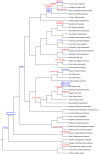Endogenous Retroviruses and Placental Evolution, Development, and Diversity
- PMID: 35954303
- PMCID: PMC9367772
- DOI: 10.3390/cells11152458
Endogenous Retroviruses and Placental Evolution, Development, and Diversity
Abstract
The main roles of placentas include physical protection, nutrient and oxygen import, export of gasses and fetal waste products, and endocrinological regulation. In addition to physical protection of the fetus, the placentas must provide immune protection throughout gestation. These basic functions are well-conserved; however, placentas are undoubtedly recent evolving organs with structural and cellular diversities. These differences have been explained for the last two decades through co-opting genes and gene control elements derived from transposable elements, including endogenous retroviruses (ERVs). However, the differences in placental structures have not been explained or characterized. This manuscript addresses the sorting of ERVs and their integration into the mammalian genomes and provides new ways to explain why placental structures have diverged.
Keywords: endogenous retrovirus (ERV); mammals; placenta; structural diversity.
Conflict of interest statement
The authors declare no conflict of interest.
Figures



Similar articles
-
Acquisition and Exaptation of Endogenous Retroviruses in Mammalian Placenta.Biomolecules. 2023 Oct 4;13(10):1482. doi: 10.3390/biom13101482. Biomolecules. 2023. PMID: 37892164 Free PMC article. Review.
-
Progressive Exaptation of Endogenous Retroviruses in Placental Evolution in Cattle.Biomolecules. 2023 Nov 21;13(12):1680. doi: 10.3390/biom13121680. Biomolecules. 2023. PMID: 38136553 Free PMC article. Review.
-
Retroviruses facilitate the rapid evolution of the mammalian placenta.Bioessays. 2013 Oct;35(10):853-61. doi: 10.1002/bies.201300059. Epub 2013 Jul 19. Bioessays. 2013. PMID: 23873343 Free PMC article.
-
Pluripotency and the endogenous retrovirus HERVH: Conflict or serendipity?Bioessays. 2016 Jan;38(1):109-17. doi: 10.1002/bies.201500096. Bioessays. 2016. PMID: 26735931 Review.
-
Genome-Wide Characterization of Zebrafish Endogenous Retroviruses Reveals Unexpected Diversity in Genetic Organizations and Functional Potentials.Microbiol Spectr. 2021 Dec 22;9(3):e0225421. doi: 10.1128/spectrum.02254-21. Epub 2021 Dec 15. Microbiol Spectr. 2021. PMID: 34908463 Free PMC article.
Cited by
-
Interaction of HERVs with PAMPs in Dysregulation of Immune Response Cascade Upon SARS-CoV-2 Infections.Int J Mol Sci. 2024 Dec 12;25(24):13360. doi: 10.3390/ijms252413360. Int J Mol Sci. 2024. PMID: 39769125 Free PMC article. Review.
-
Transcriptome Sequencing Reveals That Intact Expression of the Chicken Endogenous Retrovirus chERV3 In Vitro Can Possibly Block the Key Innate Immune Pathway.Animals (Basel). 2023 Aug 26;13(17):2720. doi: 10.3390/ani13172720. Animals (Basel). 2023. PMID: 37684986 Free PMC article.
-
Acquisition and Exaptation of Endogenous Retroviruses in Mammalian Placenta.Biomolecules. 2023 Oct 4;13(10):1482. doi: 10.3390/biom13101482. Biomolecules. 2023. PMID: 37892164 Free PMC article. Review.
-
Editorial: Cellular processes in placental morphogenesis.Front Cell Dev Biol. 2023 Oct 4;11:1298298. doi: 10.3389/fcell.2023.1298298. eCollection 2023. Front Cell Dev Biol. 2023. PMID: 37860817 Free PMC article. No abstract available.
-
Molecular approaches to mammalian uterine receptivity for conceptus implantation.J Reprod Dev. 2024 Aug 7;70(4):207-212. doi: 10.1262/jrd.2024-022. Epub 2024 May 18. J Reprod Dev. 2024. PMID: 38763760 Free PMC article. Review.
References
-
- Whittington C.M., Van Dyke J.U., Liang S.Q.T., Edwards S.V., Shine R., Thompson M.B., Grueber C.E. Understanding the evolution of viviparity using intraspecific variation in reproductive mode and transitional forms of pregnancy. Biol. Rev. Camb. Philos. Soc. 2022;97:1179–1192. doi: 10.1111/brv.12836. - DOI - PMC - PubMed
Publication types
MeSH terms
Substances
LinkOut - more resources
Full Text Sources

